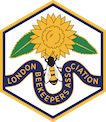
|
London Beekeepers' Association |

|
London Beekeepers' Association |
July in the Apiary[In the apiary, month by month.] Howard Nichols July beekeeping work has 2 distinct parts. These are dealing with the early July nectar flow then, at the end of the month, removal of honey. During May and June the bees utilise this period to build up their numbers and to swarm. There is now a lot less inclination to swarm and the bees direct their attention towards capturing the flowing nectar from the summer flowers. When they do this then supers can quickly fill and it is important that the beekeeper has sufficient frames and supers in advance of the flow. There will not be time to buy extra supers and to make up frames. Nor can the beekeeper extract the honey and return the super to the same colony as the honey is unlikely to be ripened until after the flow ceases. Nectar flowExact timing of the nectar flow depends upon weather and locality but is usually mid June and early July in London. How do I know when it has started? The coming and going at the colony entrance becomes a lot more purposeful when the nectar flow starts, bees leave the hive entrance in a determined and focussed way. They have the appearance of knowing exactly what they are doing and where they are going. As the nectar flow progresses then, of course, the supers also become heavier but, by this time, the flow is well underway. Adding supers. Regular inspections are still needed but the beekeeper's attention should now be directed towards checking there is enough room in the supers. A cursory glance in the top super should be sufficient. When the frames in the top super are covered with bees then it is time to add another. Many beekeepers move the frames around a little by putting a few combs of honey and nectar into the newly added top super as this encourages bees to continue onwards and upwards. The nectar flow can also be used to draw out new combs from foundation. Removing honey from the hiveA comb of honey should only be removed when it is at least 75\% sealed by the bees. This is to avoid fermentation of the final product. There are several methods of clearing bees from the supers. These can be grouped into physical methods (bee escapes, etc), chemical methods (repellents available for purchase from bee equipment suppliers) and mechanical methods (blowers which blow the bees off the frames). Some beekeepers have concerns relating to the use of chemicals and mechanical methods are more akin to commercial beekeeping, not hobbyists. It is only the physical methods detailed here. The 2 most common physical methods are Porter bee escapes and shaking the bees off the frames. Porter bee escapesMost of us use Porter bee escapes incorporated into a clearing board. This works well provided they are used properly and the metal spring escapes are clean, not stuck with propolis. After about 48 hours most of the bees have gone down through the one-way valve and there are relatively few bees in the super. Better to use a crownboard with 2 bee escapes. If 1 malfunctions then the other is still in use. Make sure there is plenty of space for the bees below the supers. If necessary then insert another empty super with frames below to house the bees. Ensure the bees cannot come back up into the supers being cleared. Ill fitting, non bee spaced equipment or defective Porter bee escapes are the usual reasons for failure. Shake and brushAnother method is shaking the individual frames to remove as many bees as possible then brushing off the remainder. An extra super is needed to hold the shaken frames and this should be placed on an upturned hive roof and covered with a sheet or large cloth. As it is being used to hold honey (a food product) then it should not have direct contact with the ground. This method causes a certain amount of disturbance to the bees and may not be suitable for a hive in close proximity to people. Its advantage is that it is quick and only involves 1 visit to the apiary. Porter bee escapes involve 2 visits to the apiary. Other action to be taken this monthCheck space. Once the nectar flow starts then most colonies abandon the idea of swarming as it is now not in their interests to do so. There is still a small risk of swarming and this is increased if the bees do not have enough room to store nectar. Another reason to ensure that enough supers are on the hive. Check space. The nectar flow is a golden opportunity to undertake a brood disease inspection. As the bees are so busy with the nectar they have little time to remove dead larvae until the flow ceases. Leaving the brood disease inspection until autumn may leave insufficient time to take corrective action. Optimum times for a specific brood disease inspection are early spring and in summer whilst the nectar flow is in progress. Reduce colony entrances. Reduce colony entrances when the nectar flow ceases to minimise robbing. Plan your varroa treatment for next month. Decide your strategy and buy any supplies you will need. Reserve your use of an extractor. Reserve your use of an extractor next month if you usually hire LBKA equipment. |
©2025 London Beekeepers' Association |